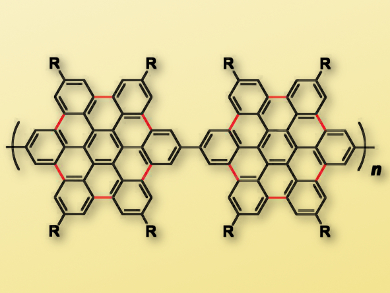Low-bandgap conjugated polymers have unique optical and electrochemical characteristics. They could have widespread applications in organic photoelectric devices. The designs of most low-bandgap polymers have focused on three factors: 1) the degree of bond length alternation, 2) the resonance energy of the aromatic unit, and 3) the substituents.
Weizhi Wang, Fudan University, Shanghai, China, and colleagues have prepared three low-bandgap polycyclic aromatic hydrocarbons with different spatial arrangements based on hexaphenylbenzene derivatives: a linear type (pictured), a V-shaped type, and a zigzag type. The team used a Yamamoto reaction with Ni(COD)2 (COD= cyclooctadiene) as a catalyst for the synthesis. The resulting compounds differ in two factors: the mean deviation from planarity and the intermolecular and interchain coupling in the solid state, respectively.
UV/Vis absorption spectroscopy and measurements of the compounds’ emission spectra showed that a higher degree of planarity in the polymer chain led to a redshift. The trend of the bandgap agrees with the optical test results. The synthesized compounds were successfully used to assemble organic field-effect transistors (OFET devices) and could have potential for use in electronic devices.
- Synthesis and Characterization of Polycyclic Aromatic Hydrocarbons with Different Spatial Constructions Based on Hexaphenylbenzene Derivatives,
Hua Chen, Haoyun Zhu, Yuli Huang, Junwei Yang, Weizhi Wang,
Chem. Asian J. 2017.
DOI: 10.1002/asia.201701061

![Synthesis of [c2]Daisy Chains via Mechanochemistry](https://www.chemistryviews.org/wp-content/uploads/2025/04/202504_RotaxanesWithSolidStateMechanochemistry-125x94.png)

